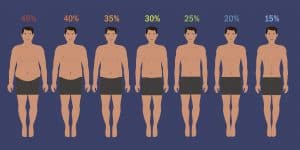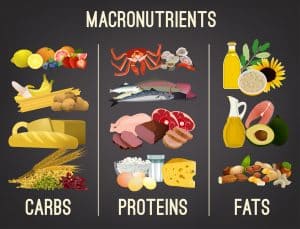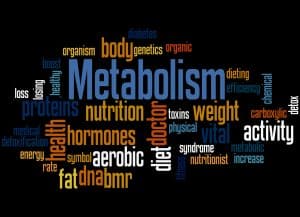You often hear the term “muscle hypertrophy” thrown here and there in the muscle and fitness community. So, what is it? and why almost everyone has to seek hypertrophy? and how to achieve it through training, diet, and supplementation?
In this article we will discuss in detail the answer to all these questions.
So, let’s get right to it.
- Table of Contents
What Is Hypertrophy?
Muscle Hypertrophy is simply muscle growth. It is the increase in the size of the skeletal muscle through the increase of the muscle cell size. Skeletal muscle is the muscle attached to the bones through tendons and contracts under voluntary control. For example, your biceps, chest, legs etc. are skeletal muscles. Your heart and stomach are not.
Muscle hypertrophy results from two factors: mechanical loading or training (like weight lifting) and proper recovery and nutrition, mainly protein and carbohydrates.
Types of Muscle Hypertrophy
The size of the skeletal muscle increases due to two types of hypertrophy:
- Sarcoplasmic (“Sarco” means flesh, and “plasmatic” plasma-like): an increase in glycogen surrounding the muscle fibers (muscle fibers are called contractile protein).
- Myofibrillar (“Myo” means muscle, and “fibrillar” means string-like structure): an increase in myofibril, or simply the number of muscle fibers (or contractile protein).
You can think of the sarcoplasmic hypertrophy as the muscle pump during the workout after carbing up, which increases the glycogen stored in the muscle. Therefore, sarcoplasmic contributes indirectly to overall hypertrophy. Myofibrillar, on the other hand, can be thought as the density of the muscle fibers and thus it makes up the vast majority of the muscle hypertrophy.
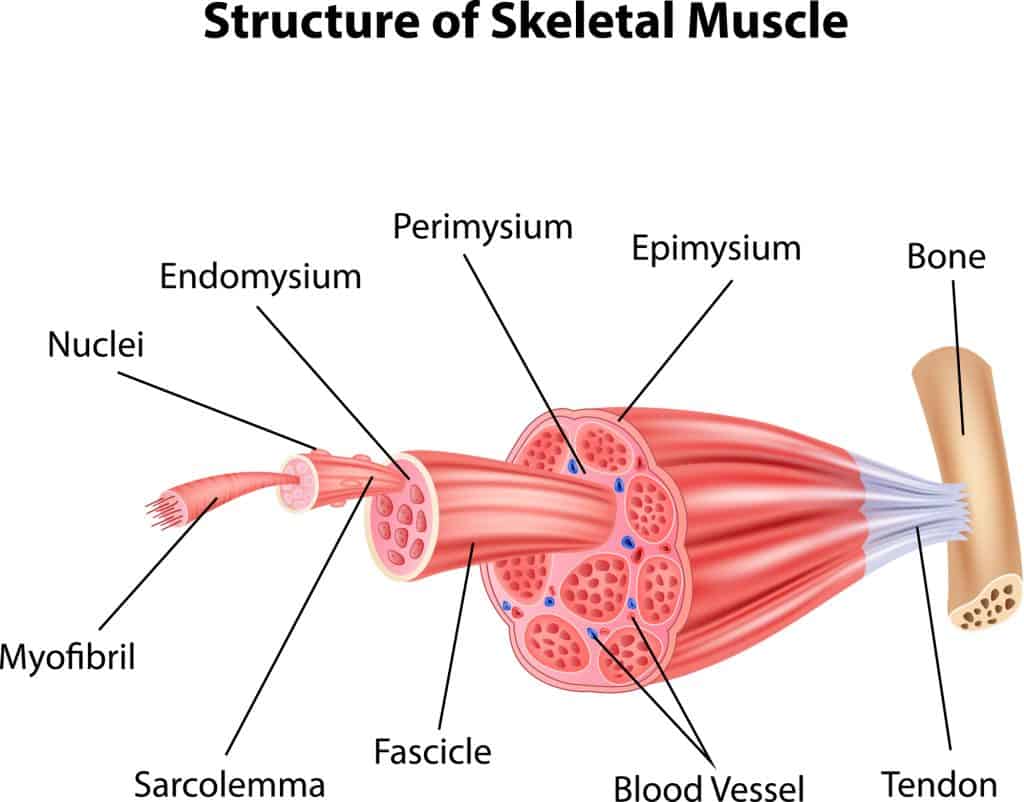
Mechanisms
There are two main phases for muscle growth: breakdown and repair. So, pertaining to the types of muscle hypertrophy above, the process of the hypertrophy can be understood under two models:
1- General Adaptation Syndrome: this is done through a series of muscle damage and repair over a long period of time resulting in an increase in muscle adaptation to the resistance.
Stimulating the muscle by contraction and stretching during training (by, say, lifting weights) causes:
(i) breaking down the internal muscle fibers (myofibrils), and …
(ii) swelling of the fluid between the fibers (pro-inflammatory markers) that leaks out of the cell and damages its membrane, which results in limiting the range of motion and skeletal muscular fatigue (or failure).
This damage depletes nitrogen that previously had accumulated in the cell to form amino acids bonds. This is known as negative nitrogen balance.
Thus, it becomes imperative to consume enough amino acids from protein sources in order to balance the negative nitrogen. This is where the repair phase takes place. Anti-inflammatory markers also come in and help support the repair process.
At rest mode, after the supply of amino acid, muscle fibers are reproduced to repair and replace the damaged ones. When more fibers are produced, that’s when muscle growth occurs.
This regeneration of fibers followed by muscle overcompensation is called general adaptation syndrome. Thus, the more weights we lift for higher repetitions, the more muscle fibers are damaged. Then, the more amino acid supplied, the more fibers are repaired and over-compensated, the more muscle growth.
2- Aerobic fatigue model: this model relies on improving the aerobic energy system by increasing the recovery of the heart rate. The idea is as follows:
By increasing the fitness level we decrease the rest time between sets. This enables doing more work in less time. Thus by enhancing the recovery time, more glycogen can be stored in the muscle due to the increase in energy consumption.
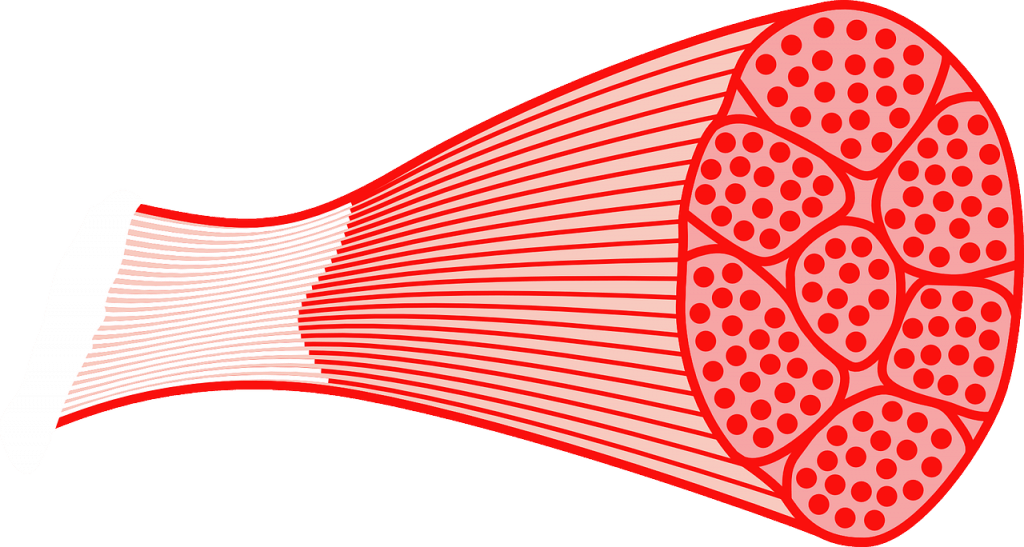
The 10 roles to Train For Hypertrophy
This is the first phase of muscle hypertrophy, which is breaking down the muscle fibers. A lot of people think they build muscles when they train. This is a common misconception. The main reason we train with weights is we want to maximize tearing as many muscle fibers as possible.
So, what are the best training strategies that maximize the breakdown? Is it better to do heavy weight and low repetitions or light weights and more repetitions? Here is a list of my top ten training strategies:
1
Train with high volume
Volume is the total number of training sets for a given muscle. Push your body to a new volume level per muscle workout every 6-12 months. Write down the weights you lift, the number of sets and repetitions you perform. Compare this record to the new record you will take after 6-12 month. This will help you track your progress. Your goal is to increase this record.
2
Train with High Frequency
Frequency by itself does not help muscle hypertrophy, but it is an alternative way to handle the high volume. Split the total volume into two separate days instead of one long training session.
For example, you can do 4 sets of, say, chest on Tuesday, and another 4 sets on Saturday. If a muscle group is lagging, train them even three times per week. So, you could train 5-6 days per week instead of only 3-4 days.
3
Recycle your training volume
Increasing your volume cannot go on forever. Your body can only handle a certain volume at any given time. At some point, the stress on the muscle and joints will risk overtraining which is a catabolic process. Your body will not be able to recover from all that volume. Instead, increase your volume every week until a maximum, then reduce the volume for a few weeks, then take your volume up again.
Here is an example: week 1-4: do 6 sets, week 5-8: do 8 sets, week 9-12: do 10 sets, week 13-16: do 8 sets, week 17-20: do 10 sets, week 21-24: do 12 sets, and so on.
As you see, by week 12 we do a lot of volume, so starting from week 13 to 16 we will slow it down and take the volume back to 8 sets only before we resume on week 17 and start with increasing volume to 10 sets, and assess the ability to do more sets the following weeks.
4
Focus on quality contraction instead of heavyweights
Try to establish the mind-muscle connection and feel the muscle contracting and stretching regardless of the weight. Quality of a set matters a lot more than the quantity. If you do not feel particular movement, try to lighten the weight or completely ignore that exercise and pick another movement that you feel.
For example, when I train my rear deltoid, I almost never use the reverse pec deck machine because it does not stimulate my rear deltoid, and I feel it more on my triceps. I use cables and dumbbells, instead.

5
Get stronger on at least one movement per muscle group and NOT all movements
For example, get stronger in shoulder presses, then when you move on to lateral raises focus on quality repetitions with lighter weights. Get stronger on leg presses but increase the sets and repetitions on leg extension, and so on.
6
Do not train compound movements to failure
Compound movements like squat and bench press involve multiple muscle groups. So, you will not entirely focus on the targeted muscle group like in isolation movements. And if you train to failure, you will less likely devote enough effort for the secondary muscle groups when trained.
7
Take your isolation movement to near failure
Lighten the weight and do as many repetitions as you can. This will breakdown a lot more fibers and push more blood to the muscle.
8
Shorten the rest between isolation movements
This will increase your fitness levels and boost your aerobic system. In addition, lactic acid accumulation in the muscle, which gives you the burning feeling, enhances growth hormone production; a major anabolic hormone.
9
Prioritize Lagging Body Parts
Start your workout session with the weaker muscles. You don’t want to see huge discrepancies and muscular imbalances. A notorious example is lagging leg development. You can easily spot that person who never trains legs! Another example is rear deltoid, and triceps.
10
Training split does matter
Do not combine two big muscles in the same session. Instead, you can combine one big muscle group with a smaller one. For example, chest and bicep, back and tricep. In this case, train the big muscle group first. Or, you can do arms, biceps and triceps, on one session.
Repairing Torn Fibers
Weightlifting is only the easy part! Outside the gym is where the hard work begins. Why? Because that’s where you spend the rest of the 24 hours! You need to repair and over-compensate the damaged fibers.
You will need to focus on nutrition, supplementation, and of course, recovery.

Eating Tips
The major key when it comes to hypertrophy nutrition is to be on a caloric surplus. This means you have to consume more calories than you burn in a day. Although muscle hypertrophy is not impossible on a caloric deficit, it was shown that a deficit reduces the anabolic hormones levels and increases the cortisol levels, which is a catabolic hormone.
- Protein: in the repair phase you need a sufficient amount of amino acids, your protein intake needs to be at high levels of at least 1 gram per pound of body weight. This is critical for myofibrillar hypertrophy, and enhances protein synthesis.
- Complex Carbohydrates: you will also need to maintain enough glycogen in the muscle cells for fast glucose supply. Thus, complex carbohydrates are essentials for sarcoplasmic hypertrophy. This is why you cannot build muscle on a keto diet.
- Fats: like Omega-3,-6 and-9 are caloric dense with about 9 Calories per gram. They are important for nutrients absorption in the cell. Good fats will increase the levels of good cholesterol (or DHL) which will help you boost your testosterone and growth hormone. These hormones will increase protein synthesis and amino acid production.
Foods like peanuts and watermelon are rich in arginine, citrulline, respectively, which are good for muscle pump during the workout.
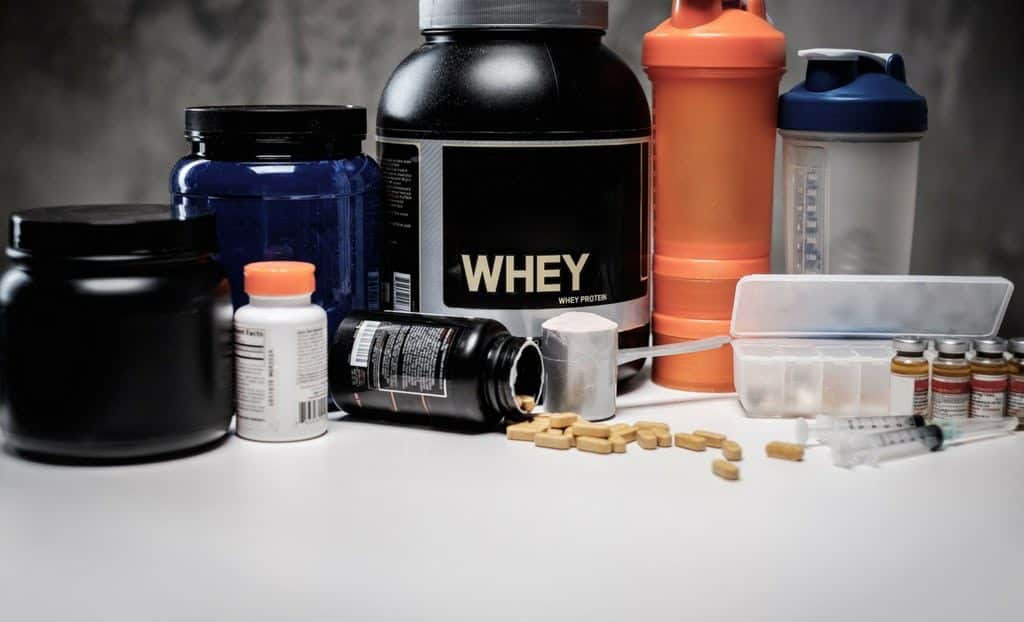
Supplementation for Muscle Hypertrophy
I would categorize hypertrophy supplementation into three categories:
- Nutrition Supplementation: these include protein shakes, essential and branched chain amino acids (BCAAs), will help with muscle recovery and soreness, and help you perform better at all the daily activities not only training.
- Carbohydrates: sometimes it is not practical to have food in the stomach all the time. Supplementing your carbohydrates in a liquid form is an easy way to make sure your intake is high enough. This way you are restoring muscle glycogen at a faster rate, which will give you a better pump because of a faster supply of glucose in your system.
Also, if you are a hard gainer, do not shy away from reputable weight gainers for muscle growth. - Pump supplements like citrulline and arginine (both are amino acids) are some of the best pumping agents. It is really hard to get enough of these amino acids from food alone. You need upward of 6-8 grams in a single dose to get a good muscle pump.
- Immune system supplementation: glutamine, iron, vitamin C and vitamin D3 all are shown to enhance the immune system and minimize the risk of catching a viral or bacterial infection.
- Sleep aid supplementation: supplements like melatonin and valerian will help you sleep faster and stay in the deep sleep for longer periods. So you are waking up in the morning more recovered.
8 Tips for Muscle Recovery
Extra rest and sleep are key in muscle hypertrophy. Here are some tips:
- Take a nap in the middle of the day. A short nap of 30 minutes can greatly boost your recovery.
- Remain at a rest mode for 2-3 hours post workout. For example, try to avoid hard physical work right after training. You could also perform your work duties while sitting on a desk.
- Avoid stimulants 8 hours before bedtime.
- If possible, sleep for longer hours.
However, sometimes extra rest and sleep is not an option during a busy schedule. Here are some other options for enhancing recovery:
- Go for massage therapy, preferably deep tissue massage, or other therapies that have a relaxing effect on the body.
- Increase glutamine intake up to 35 grams per day spread throughout the day.
- Double your dose of BCAAs.
- Use supplements to enhance the quality of your sleep.

Effects Of Genetics, Age, And Gender
Factors beyond our control like gender, age, and gender significantly affect muscle hypertrophy.
To understand how these factors impact growth we need to look at the hormones responsible for muscle hypertrophy first.
Influential Hormones
The following hormones are called anabolic hormones because they help building muscle tissues. Some directly enhance muscle growth, and others indirectly by affecting the way glucose is used and stored in the muscles.
- Testosterone: is the male hormone produced by the adrenal glands and the testicles. It is both an anabolic and androgenic (male characteristics). Therefore, it is the most important hormone for muscle growth. Muscles have receptors for growth called anabolic receptors. Testosterone stimulates these receptors molecules in the cell by activating certain genes to produce and synthesize protein.
- Growth Hormone (GH): produced by the pituitary gland. It stimulates the liver to produce the ultimate muscle growth hormone which is IGF-1 (Insulin-like growth factor-1). IGF-1 levels can be stimulated by increasing protein intake. Both GH and IGF-1 hormones help reduce body fat (lipolysis).
- Insulin: produced by the pancreas, insulin is a hormone whose molecules are peptide protein. It is responsible for storing the broken down carbohydrates, glucose, as glycogen in the muscle cells and the liver. It is also responsible for amino acid functionality of repairing the damaged muscular fibers.
Age and Gender effects
Both Testosterone and growth hormone levels decrease rapidly with age. Thus, you can expect a decline in muscle hypertrophy with age naturally if not supplemented externally.
Unlike testosterone, growth hormone levels are much higher in women than in men. The reason why this is the case is not fully understood. However, some studies suggested that estrogen (female characteristics hormone) can increase GH secretion in premenopausal women.
Genetics
It is not surprising to know that one of the most important genetic factors in muscle hypertrophy is the body type determined by the skeleton bone frame. Mesomorphic body is naturally muscular. Ectomorphic is thin (and hard gainer), while endomorphic is rounded and accumulates more fat.
It was shown that people with a larger skeleton frame tend to have more fat-free mass (FFM). The increase in the FFM is also associated with an increase in strength.
Summary
Muscle hypertrophy is a term for muscle growth. There are two types of hypertrophy: sarcoplasmic (fluid between muscle fibers) made up of glycogen, water, vitamins, and minerals, and myofibrillar which is string-like muscle fibers made up of long protein structures.
In order to increase your muscular hypertrophy you need to work on the two hypertrophy phases:
(i) Breakdown the muscular fibers during training. Use high volume. Combine heavy compound movements with lower repetitions and light-to-moderate weights with high repetitions to near failure.
(ii) Repair the torn fibers by nutrition and recovery. Eat high enough protein and carbohydrates to provide enough supply of amino acids and glycogen to the muscles.
Deep sleep and extra rest are as important in the repair process.
Supplement your food with protein shakes, carbohydrates, essential fatty acids, and glutamine, iron and vitamin C to strengthen the immune system. If necessary, you may also want to supplement sleep aid to help you with the quality of your sleep.
Although genetics, age, and gender play a role the hypertrophy, hard work and consistency are the ultimate keys to achieve muscular hypertrophy.








